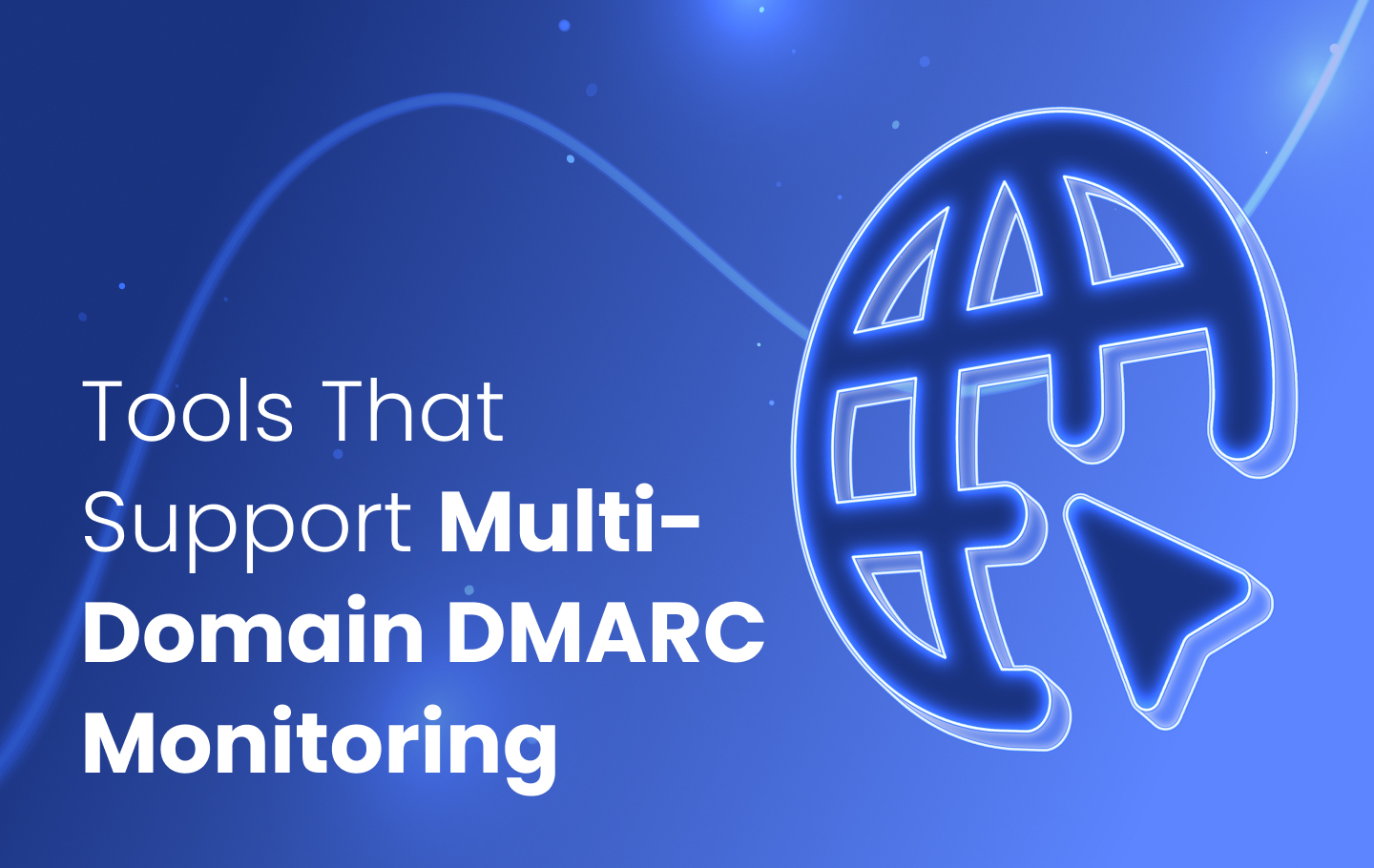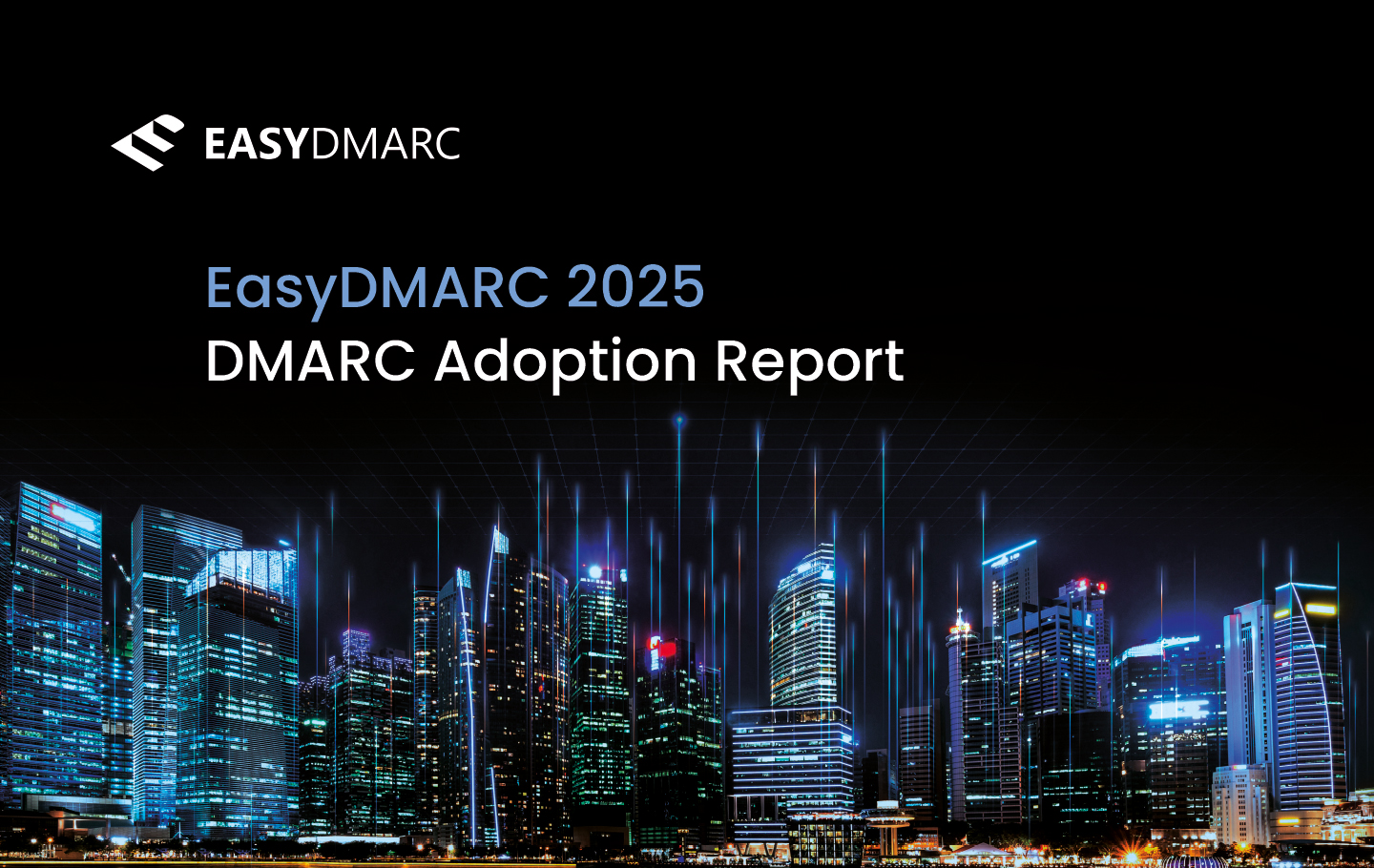As email threats grow more sophisticated, enterprise organizations and Managed Service Providers (MSPs) must protect not just one domain, but often dozens or even hundreds across different brands, subsidiaries, or clients. That’s where multi-domain DMARC monitoring becomes essential.
Managing DMARC for a single domain is complex enough, but managing multiple — each with its own email infrastructure, third-party senders, and compliance needs — multiplies that complexity. Without the right tools, it’s a time-consuming and error-prone process.Multi-domain DMARC tools simplify this challenge. They centralize domain monitoring, streamline email authentication, and help reduce fraud, improve deliverability, and ensure compliance across the board.
In this article, we’ll cover what multi-domain DMARC monitoring is, why it matters, and highlight the vendors that offer the best solutions for organizations with complex domain portfolios.
What is Multi-Domain DMARC Monitoring?
Multi-domain DMARC monitoring refers to the ability to oversee and manage email authentication for multiple domains from a single platform. Rather than logging into separate dashboards or handling domain configurations manually, users can monitor, analyze, and enforce DMARC policies across all domains from a centralized interface.
This approach is especially valuable for MSPs and large enterprises that operate numerous brands or subsidiaries. With multi-domain monitoring, teams can easily detect spoofing attempts, manage DNS records, and track policy enforcement all in one place.
By consolidating domain oversight, businesses gain better visibility, reduce the chance of misconfigurations, and can enforce consistent security policies. These platforms typically integrate DMARC, SPF, DKIM, and sometimes BIMI, MTA-STS, and TLS-RPT to create a full email authentication ecosystem.

DMARC Vendors That Support Multi-Domain DMARC Monitoring
Several DMARC vendors support multi-domain DMARC monitoring, but each brings unique strengths to the table. Some organizations prioritize expert support, while others focus on multi-tenant management, seamless integrations, or advanced threat intelligence. Platforms like EasyDMARC offer capabilities to help organizations monitor and manage email authentication across multiple domains.
1. EasyDMARC
EasyDMARC is the ideal choice for enterprise businesses and MSPs looking for hands-on DMARC support and straightforward domain management. The platform is built for organizations that want to monitor and enforce DMARC policies across multiple domains without drowning in complexity.
EasyDMARC combines automation, user-friendly design, DMARC checkers, and expert support to make multi-domain monitoring seamless and scalable for those monitoring hundreds or even thousands of domains.
EasyDMARC’s key features include:
- Multi-domain management
EasyDMARC’s intuitive interface allows enterprises and MSPs to add, authenticate, and track domains in just a few clicks. The centralized view helps teams identify issues quickly and maintain consistent DMARC policy enforcement. - Managed services
For organizations seeking hands-off support, EasyDMARC offers fully managed DMARC, SPF, DKIM, and BIMI setup. Enterprise customers also benefit from 24/7 email support and a dedicated DMARC engineer who ensures domain configurations stay secure and compliant. - Smart DMARC reporting
EasyDMARC transforms raw DMARC XML data into easy-to-read reports. Users can drill down into sending sources, detect unauthorized usage, and view trends over time from a single dashboard. - Simplified SPF management
Long SPF records and the 10-DNS-lookup limit are common problems in email authentication. EasySPF helps users build and maintain optimized SPF records, avoiding email delivery issues due to DNS lookups or syntax errors. - Alert management
The EasyDMARC platform notifies users about issues like domain spoofing attempts, misaligned emails, or failed authentication checks so businesses can stay ahead of security threats. - User-friendly UI
The user interface is designed with simplicity and speed in mind. Even teams unfamiliar with DMARC can navigate the platform, access reports, and take action with a minimal learning curve. - In-depth educational resources
EasyDMARC offers extensive knowledge base articles, webinars, onboarding guides, and even a DMARC Academy to help customers at every stage of their email authentication journey.
2. MXToolBox
MXToolbox, established in 2004 and headquartered in Austin, Texas, is a privately owned company that offers fast, free, and reliable network diagnostic and lookup tools. Serving millions of technology professionals worldwide, MXToolbox helps address a variety of infrastructure challenges. Many of the company’s tools were initially created for internal use but were later shared with the broader community due to their value. As the company continues to grow, MXToolbox remains committed to developing innovative tools and services to meet the changing needs of its users.
4. Agari
Agari, now part of Fortra, offers cloud-native email security tools that combine DMARC enforcement with AI-powered threat detection and intelligence. Co-founded by one of the developers of the DMARC standard, Agari extends beyond authentication with features like suspicious email analysis and real-time monitoring.
The platform protects against phishing, spoofing, and business email compromise while helping organizations build trust and visibility across their digital communication channels.
5. dmarcian
Founded by one of the original authors of the DMARC specification, dmarcian focuses on making DMARC accessible and practical for organizations of all sizes. It serves industries like finance, telecom, government, and marketing with tools, support, and training resources.
Its DMARC Academy offers a free, comprehensive learning path covering DMARC, SPF, and DKIM. With offices and data centers in multiple regions—including North America, Europe, and Asia-Pacific—dmarcian meets strict data residency and sovereignty requirements.
6. OnDMARC by Red Sift
OnDMARC, part of the Red Sift Pulse Platform, is a fully automated, cloud-based solution for email authentication. It simplifies the implementation and monitoring of DMARC, SPF, DKIM, MTA-STS, and BIMI, without requiring manual DNS updates.
Designed to combat phishing, spoofing, and email compromise, OnDMARC is ideal for organizations seeking a hands-off, secure way to enforce domain protection across their email ecosystem.
Why is Multi-Domain DMARC Monitoring Good for Businesses?
As cyber threats continue to grow, organizations can no longer afford fragmented or manual email security strategies. Multi-domain DMARC monitoring helps businesses and MSPs centralize control while gaining the visibility they need to make informed decisions.
Here are some of the key benefits of multi-domain DMARC monitoring:
- Monitor fraud and prevent email spoofing
Multi-domain monitoring ensures that all domains are protected from spoofing attempts. Real-time visibility into authentication failures helps teams spot unauthorized senders quickly. - Improve email deliverability
By ensuring only authenticated emails are sent from verified domains, businesses improve their sender reputation, leading to better inbox placement and fewer bounces. - Maintain compliance with industry standards
Many industries require email authentication for compliance (e.g., PCI DSS, GDPR, HIPAA). Multi-domain monitoring ensures your entire domain portfolio adheres to regulatory requirements. - Enhance operational efficiency
Enterprises and MSPs can benefit from the enhanced operational efficiency that multi-domain DMARC monitoring provides. These businesses can manage all their domains from a single interface, streamline onboarding, and reduce time spent on manual configuration and troubleshooting.

Multiple Domains Require Advanced DMARC Solutions
Multi-domain DMARC monitoring plays a critical role in securing email communication for organizations managing multiple domains. Managing corporate domains, sub-brands, or client environments becomes significantly easier with a centralized platform for email authentication. It streamlines operations while reducing the risk of spoofing and phishing attacks.
By consolidating DMARC, SPF, and DKIM monitoring under one roof, businesses can improve email deliverability, ensure compliance with evolving security standards, and gain full visibility into their email ecosystem. With the right solution in place, teams can move from reactive to proactive email security to protect their brand, data, and reputation at scale.
Ultimately, the best tool is one that aligns with your organization’s needs, offers reliable support, and scales with your growth. Take the time to evaluate your options and choose a solution that empowers your team to manage domain security with confidence and clarity.
Frequently Asked Questions
Multi-domain DMARC monitoring allows businesses to manage and oversee email authentication for multiple domains from a single platform. This centralized approach makes it easier for enterprises and MSPs to enforce consistent DMARC policies, track authentication failures, and prevent spoofing across various domains.
Multi-domain DMARC monitoring provides centralized control for managing email authentication across multiple domains. Instead of requiring separate management for each domain, multi-domain monitoring improves operational efficiency and reduces the risk of misconfigurations. It allows businesses to simultaneously protect all their domains from spoofing and phishing threats, ensure compliance with industry standards, and maintain consistent email security policies across all domains from one platform.
EasyDMARC provides a user-friendly interface that simplifies managing multiple domains. It offers automated setup, smart DMARC reporting, and managed services, allowing enterprises and MSPs to efficiently handle email authentication, enforce policies, and receive expert support for optimal domain protection.
Yes, by ensuring that only authenticated emails are sent from verified domains, multi-domain DMARC monitoring enhances a company’s sender reputation, which results in better inbox placement and fewer email bounces. This improves overall email deliverability across all monitored domains.


